MGT302 - Strategic Management: Woolworths and Australian Supermarkets
VerifiedAdded on 2023/06/08
|15
|3139
|458
Case Study
AI Summary
This report analyzes the strategic management of Woolworths in the Australian supermarket industry, examining the macro-environment, industry dynamics, and company-specific factors. It identifies Coles and Metcash as primary competitors, with Aldi posing a significant threat as a new entrant. The analysis employs Porter's Five Forces and VRIO framework to assess Woolworths' competitive position and core competencies. The report concludes with strategic recommendations for Woolworths to enhance its competitive advantage and sustain growth in the face of evolving market challenges. Desklib is a great platform to find similar solved assignments.
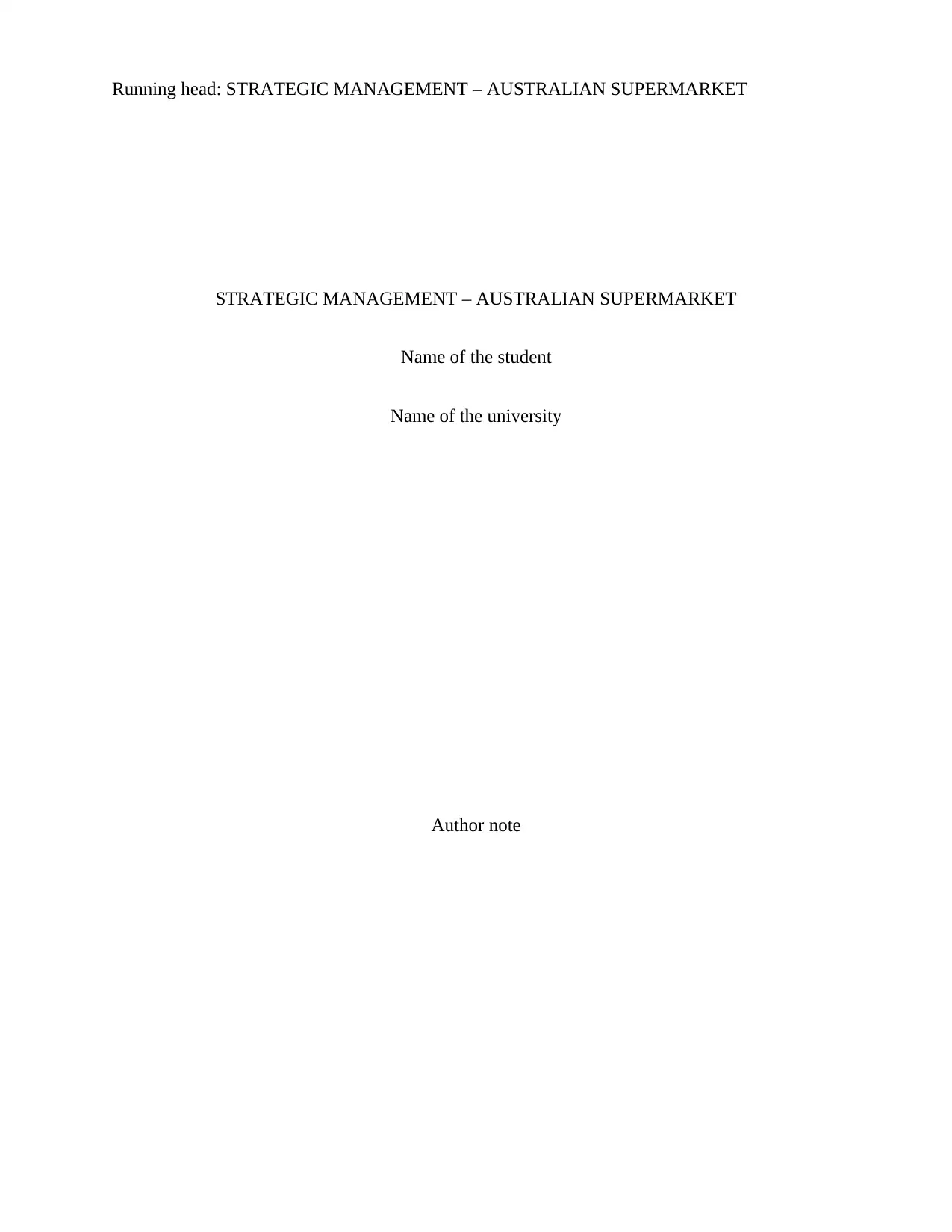
Running head: STRATEGIC MANAGEMENT – AUSTRALIAN SUPERMARKET
STRATEGIC MANAGEMENT – AUSTRALIAN SUPERMARKET
Name of the student
Name of the university
Author note
STRATEGIC MANAGEMENT – AUSTRALIAN SUPERMARKET
Name of the student
Name of the university
Author note
Paraphrase This Document
Need a fresh take? Get an instant paraphrase of this document with our AI Paraphraser
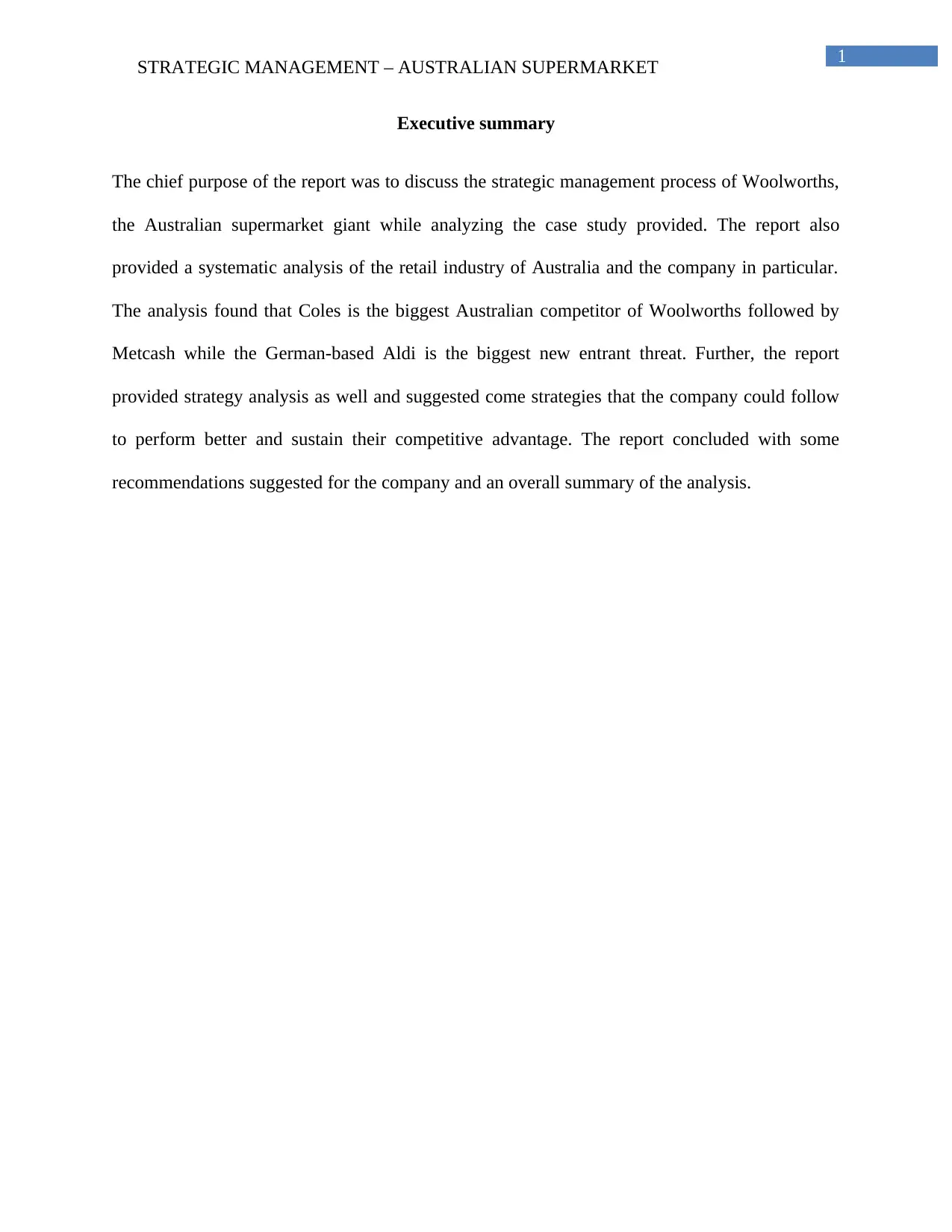
1
STRATEGIC MANAGEMENT – AUSTRALIAN SUPERMARKET
Executive summary
The chief purpose of the report was to discuss the strategic management process of Woolworths,
the Australian supermarket giant while analyzing the case study provided. The report also
provided a systematic analysis of the retail industry of Australia and the company in particular.
The analysis found that Coles is the biggest Australian competitor of Woolworths followed by
Metcash while the German-based Aldi is the biggest new entrant threat. Further, the report
provided strategy analysis as well and suggested come strategies that the company could follow
to perform better and sustain their competitive advantage. The report concluded with some
recommendations suggested for the company and an overall summary of the analysis.
STRATEGIC MANAGEMENT – AUSTRALIAN SUPERMARKET
Executive summary
The chief purpose of the report was to discuss the strategic management process of Woolworths,
the Australian supermarket giant while analyzing the case study provided. The report also
provided a systematic analysis of the retail industry of Australia and the company in particular.
The analysis found that Coles is the biggest Australian competitor of Woolworths followed by
Metcash while the German-based Aldi is the biggest new entrant threat. Further, the report
provided strategy analysis as well and suggested come strategies that the company could follow
to perform better and sustain their competitive advantage. The report concluded with some
recommendations suggested for the company and an overall summary of the analysis.
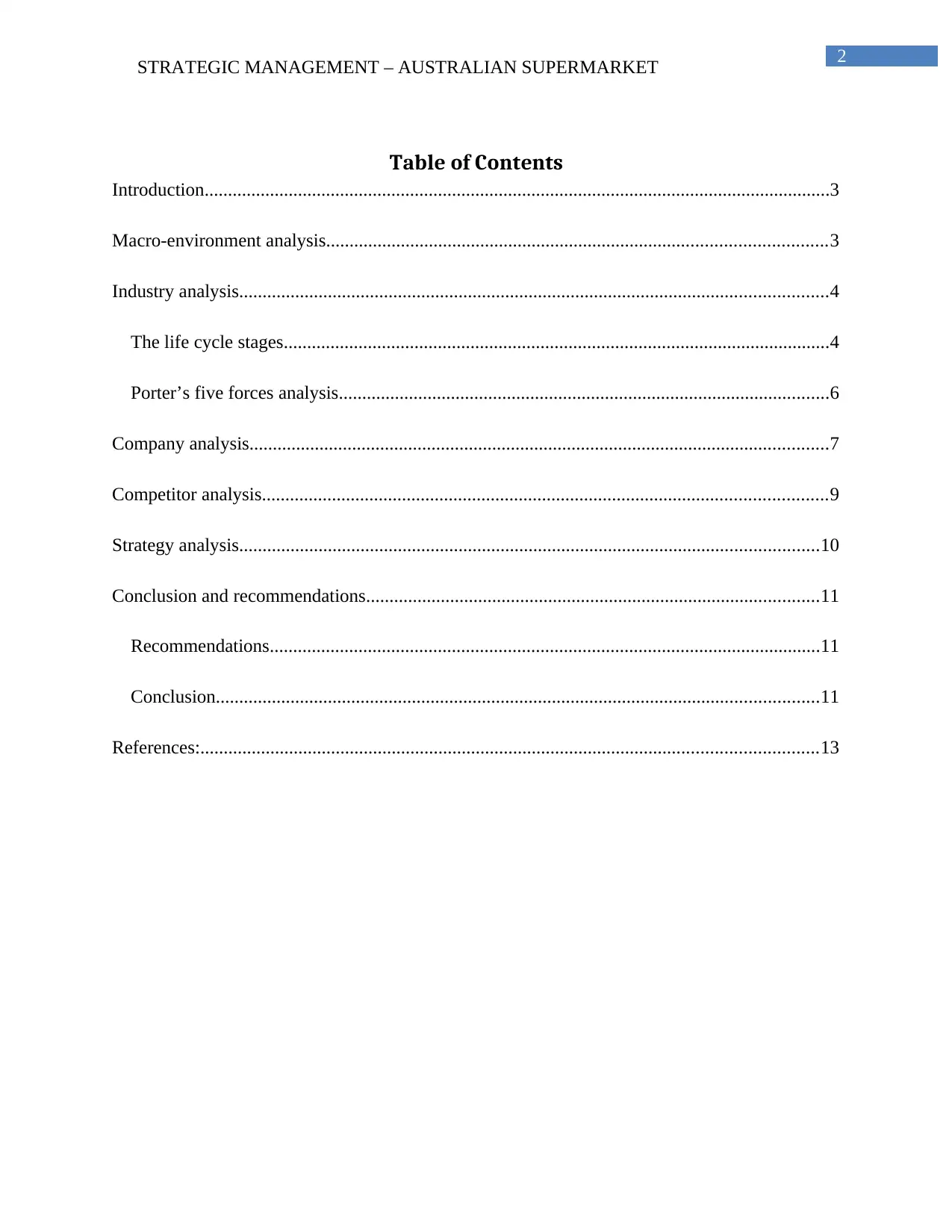
2
STRATEGIC MANAGEMENT – AUSTRALIAN SUPERMARKET
Table of Contents
Introduction......................................................................................................................................3
Macro-environment analysis...........................................................................................................3
Industry analysis..............................................................................................................................4
The life cycle stages.....................................................................................................................4
Porter’s five forces analysis.........................................................................................................6
Company analysis............................................................................................................................7
Competitor analysis.........................................................................................................................9
Strategy analysis............................................................................................................................10
Conclusion and recommendations.................................................................................................11
Recommendations......................................................................................................................11
Conclusion.................................................................................................................................11
References:....................................................................................................................................13
STRATEGIC MANAGEMENT – AUSTRALIAN SUPERMARKET
Table of Contents
Introduction......................................................................................................................................3
Macro-environment analysis...........................................................................................................3
Industry analysis..............................................................................................................................4
The life cycle stages.....................................................................................................................4
Porter’s five forces analysis.........................................................................................................6
Company analysis............................................................................................................................7
Competitor analysis.........................................................................................................................9
Strategy analysis............................................................................................................................10
Conclusion and recommendations.................................................................................................11
Recommendations......................................................................................................................11
Conclusion.................................................................................................................................11
References:....................................................................................................................................13
⊘ This is a preview!⊘
Do you want full access?
Subscribe today to unlock all pages.

Trusted by 1+ million students worldwide
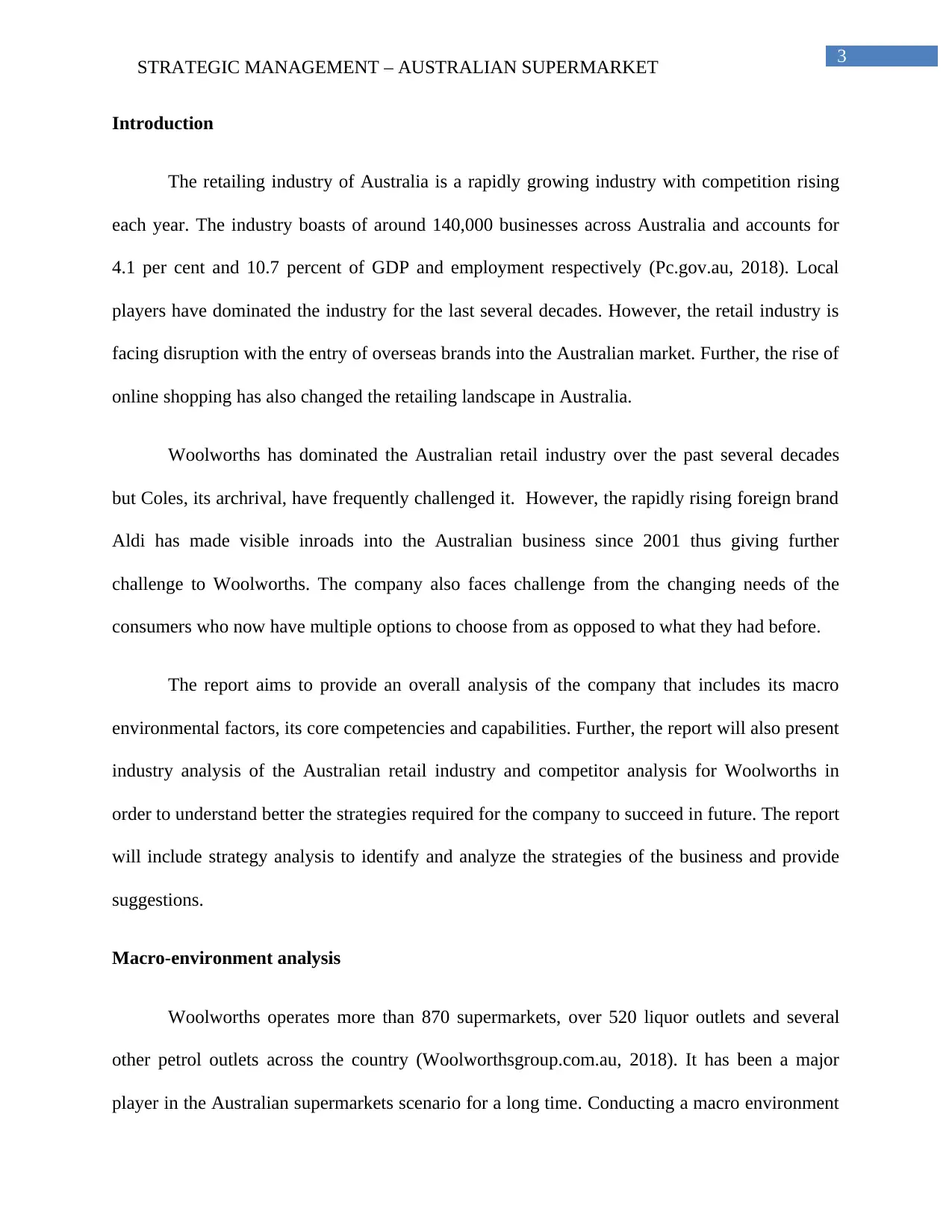
3
STRATEGIC MANAGEMENT – AUSTRALIAN SUPERMARKET
Introduction
The retailing industry of Australia is a rapidly growing industry with competition rising
each year. The industry boasts of around 140,000 businesses across Australia and accounts for
4.1 per cent and 10.7 percent of GDP and employment respectively (Pc.gov.au, 2018). Local
players have dominated the industry for the last several decades. However, the retail industry is
facing disruption with the entry of overseas brands into the Australian market. Further, the rise of
online shopping has also changed the retailing landscape in Australia.
Woolworths has dominated the Australian retail industry over the past several decades
but Coles, its archrival, have frequently challenged it. However, the rapidly rising foreign brand
Aldi has made visible inroads into the Australian business since 2001 thus giving further
challenge to Woolworths. The company also faces challenge from the changing needs of the
consumers who now have multiple options to choose from as opposed to what they had before.
The report aims to provide an overall analysis of the company that includes its macro
environmental factors, its core competencies and capabilities. Further, the report will also present
industry analysis of the Australian retail industry and competitor analysis for Woolworths in
order to understand better the strategies required for the company to succeed in future. The report
will include strategy analysis to identify and analyze the strategies of the business and provide
suggestions.
Macro-environment analysis
Woolworths operates more than 870 supermarkets, over 520 liquor outlets and several
other petrol outlets across the country (Woolworthsgroup.com.au, 2018). It has been a major
player in the Australian supermarkets scenario for a long time. Conducting a macro environment
STRATEGIC MANAGEMENT – AUSTRALIAN SUPERMARKET
Introduction
The retailing industry of Australia is a rapidly growing industry with competition rising
each year. The industry boasts of around 140,000 businesses across Australia and accounts for
4.1 per cent and 10.7 percent of GDP and employment respectively (Pc.gov.au, 2018). Local
players have dominated the industry for the last several decades. However, the retail industry is
facing disruption with the entry of overseas brands into the Australian market. Further, the rise of
online shopping has also changed the retailing landscape in Australia.
Woolworths has dominated the Australian retail industry over the past several decades
but Coles, its archrival, have frequently challenged it. However, the rapidly rising foreign brand
Aldi has made visible inroads into the Australian business since 2001 thus giving further
challenge to Woolworths. The company also faces challenge from the changing needs of the
consumers who now have multiple options to choose from as opposed to what they had before.
The report aims to provide an overall analysis of the company that includes its macro
environmental factors, its core competencies and capabilities. Further, the report will also present
industry analysis of the Australian retail industry and competitor analysis for Woolworths in
order to understand better the strategies required for the company to succeed in future. The report
will include strategy analysis to identify and analyze the strategies of the business and provide
suggestions.
Macro-environment analysis
Woolworths operates more than 870 supermarkets, over 520 liquor outlets and several
other petrol outlets across the country (Woolworthsgroup.com.au, 2018). It has been a major
player in the Australian supermarkets scenario for a long time. Conducting a macro environment
Paraphrase This Document
Need a fresh take? Get an instant paraphrase of this document with our AI Paraphraser
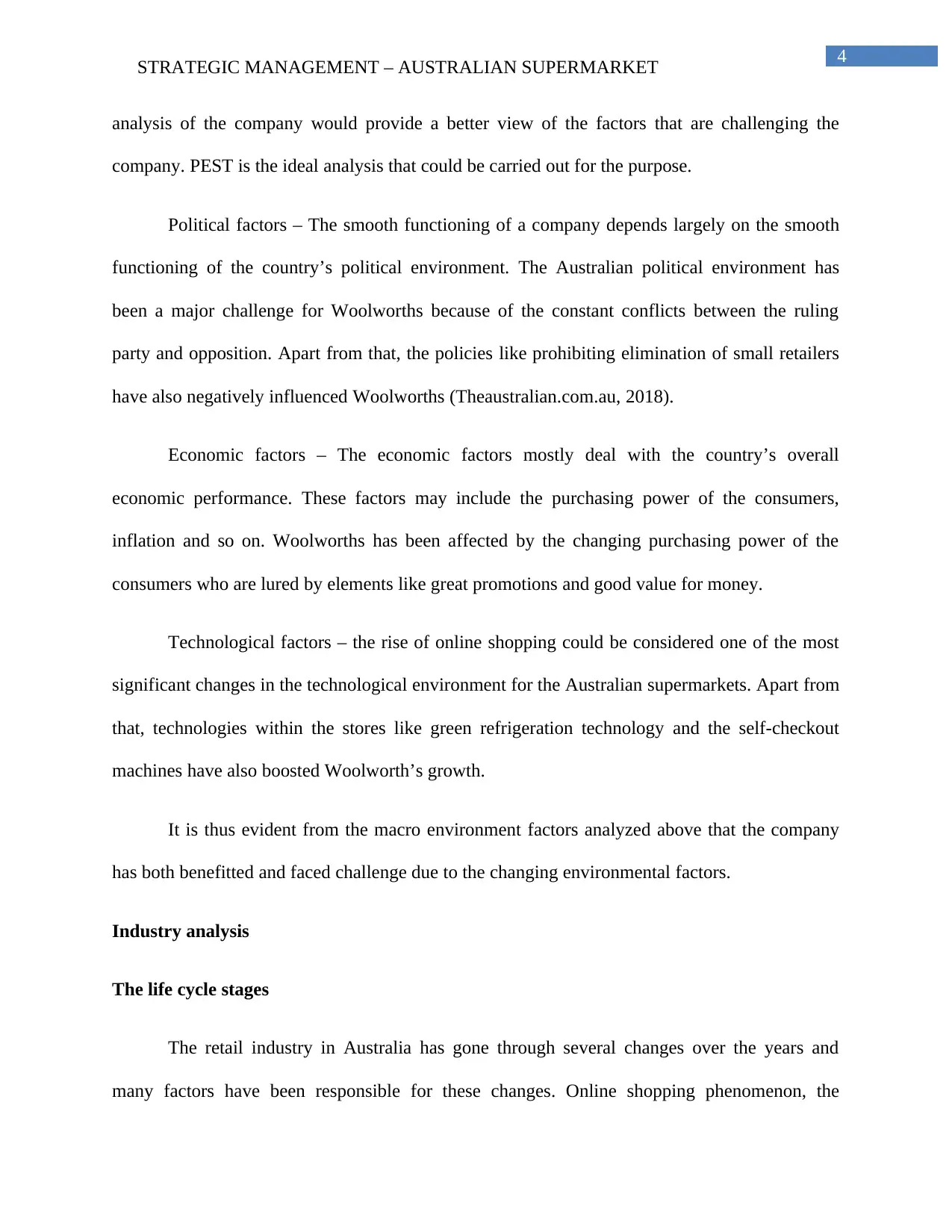
4
STRATEGIC MANAGEMENT – AUSTRALIAN SUPERMARKET
analysis of the company would provide a better view of the factors that are challenging the
company. PEST is the ideal analysis that could be carried out for the purpose.
Political factors – The smooth functioning of a company depends largely on the smooth
functioning of the country’s political environment. The Australian political environment has
been a major challenge for Woolworths because of the constant conflicts between the ruling
party and opposition. Apart from that, the policies like prohibiting elimination of small retailers
have also negatively influenced Woolworths (Theaustralian.com.au, 2018).
Economic factors – The economic factors mostly deal with the country’s overall
economic performance. These factors may include the purchasing power of the consumers,
inflation and so on. Woolworths has been affected by the changing purchasing power of the
consumers who are lured by elements like great promotions and good value for money.
Technological factors – the rise of online shopping could be considered one of the most
significant changes in the technological environment for the Australian supermarkets. Apart from
that, technologies within the stores like green refrigeration technology and the self-checkout
machines have also boosted Woolworth’s growth.
It is thus evident from the macro environment factors analyzed above that the company
has both benefitted and faced challenge due to the changing environmental factors.
Industry analysis
The life cycle stages
The retail industry in Australia has gone through several changes over the years and
many factors have been responsible for these changes. Online shopping phenomenon, the
STRATEGIC MANAGEMENT – AUSTRALIAN SUPERMARKET
analysis of the company would provide a better view of the factors that are challenging the
company. PEST is the ideal analysis that could be carried out for the purpose.
Political factors – The smooth functioning of a company depends largely on the smooth
functioning of the country’s political environment. The Australian political environment has
been a major challenge for Woolworths because of the constant conflicts between the ruling
party and opposition. Apart from that, the policies like prohibiting elimination of small retailers
have also negatively influenced Woolworths (Theaustralian.com.au, 2018).
Economic factors – The economic factors mostly deal with the country’s overall
economic performance. These factors may include the purchasing power of the consumers,
inflation and so on. Woolworths has been affected by the changing purchasing power of the
consumers who are lured by elements like great promotions and good value for money.
Technological factors – the rise of online shopping could be considered one of the most
significant changes in the technological environment for the Australian supermarkets. Apart from
that, technologies within the stores like green refrigeration technology and the self-checkout
machines have also boosted Woolworth’s growth.
It is thus evident from the macro environment factors analyzed above that the company
has both benefitted and faced challenge due to the changing environmental factors.
Industry analysis
The life cycle stages
The retail industry in Australia has gone through several changes over the years and
many factors have been responsible for these changes. Online shopping phenomenon, the
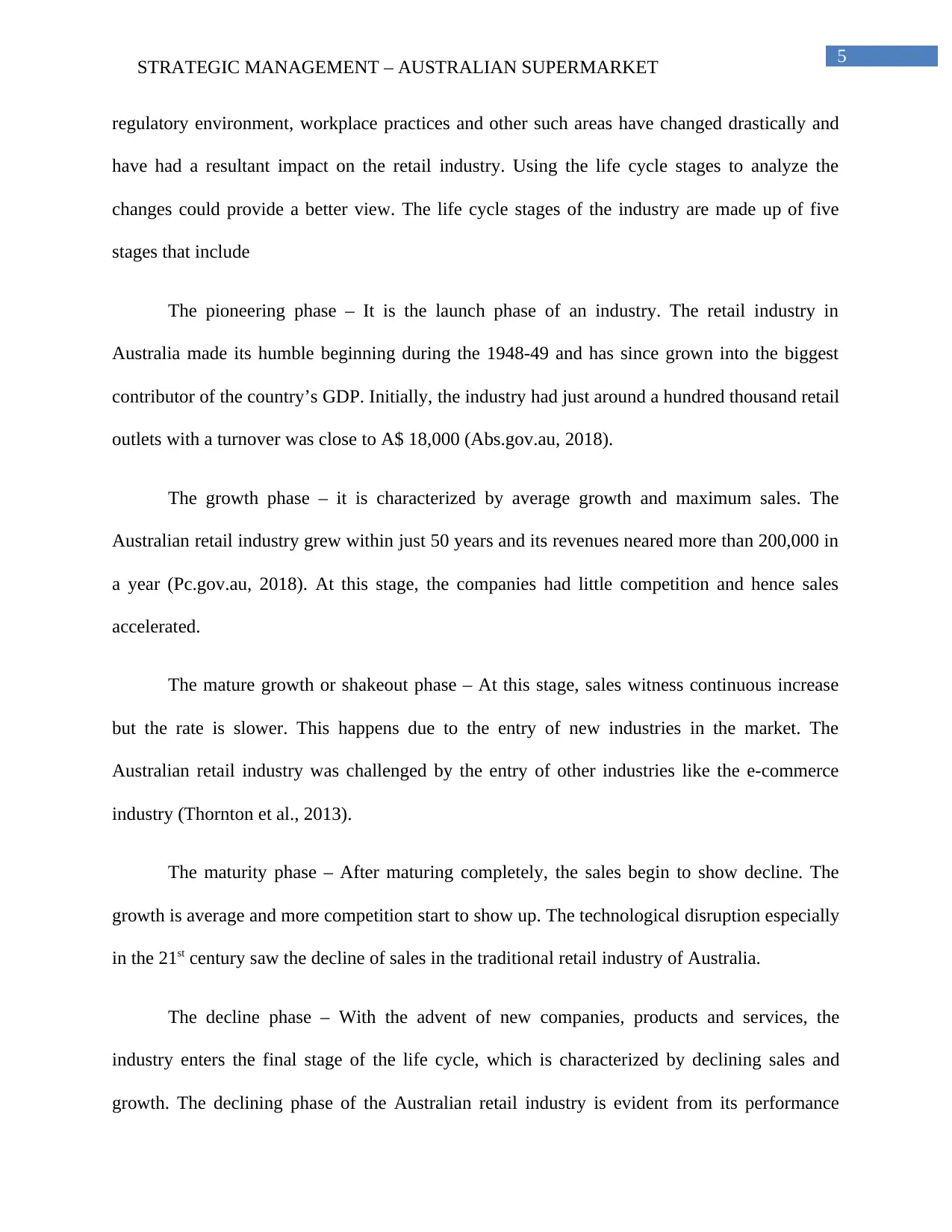
5
STRATEGIC MANAGEMENT – AUSTRALIAN SUPERMARKET
regulatory environment, workplace practices and other such areas have changed drastically and
have had a resultant impact on the retail industry. Using the life cycle stages to analyze the
changes could provide a better view. The life cycle stages of the industry are made up of five
stages that include
The pioneering phase – It is the launch phase of an industry. The retail industry in
Australia made its humble beginning during the 1948-49 and has since grown into the biggest
contributor of the country’s GDP. Initially, the industry had just around a hundred thousand retail
outlets with a turnover was close to A$ 18,000 (Abs.gov.au, 2018).
The growth phase – it is characterized by average growth and maximum sales. The
Australian retail industry grew within just 50 years and its revenues neared more than 200,000 in
a year (Pc.gov.au, 2018). At this stage, the companies had little competition and hence sales
accelerated.
The mature growth or shakeout phase – At this stage, sales witness continuous increase
but the rate is slower. This happens due to the entry of new industries in the market. The
Australian retail industry was challenged by the entry of other industries like the e-commerce
industry (Thornton et al., 2013).
The maturity phase – After maturing completely, the sales begin to show decline. The
growth is average and more competition start to show up. The technological disruption especially
in the 21st century saw the decline of sales in the traditional retail industry of Australia.
The decline phase – With the advent of new companies, products and services, the
industry enters the final stage of the life cycle, which is characterized by declining sales and
growth. The declining phase of the Australian retail industry is evident from its performance
STRATEGIC MANAGEMENT – AUSTRALIAN SUPERMARKET
regulatory environment, workplace practices and other such areas have changed drastically and
have had a resultant impact on the retail industry. Using the life cycle stages to analyze the
changes could provide a better view. The life cycle stages of the industry are made up of five
stages that include
The pioneering phase – It is the launch phase of an industry. The retail industry in
Australia made its humble beginning during the 1948-49 and has since grown into the biggest
contributor of the country’s GDP. Initially, the industry had just around a hundred thousand retail
outlets with a turnover was close to A$ 18,000 (Abs.gov.au, 2018).
The growth phase – it is characterized by average growth and maximum sales. The
Australian retail industry grew within just 50 years and its revenues neared more than 200,000 in
a year (Pc.gov.au, 2018). At this stage, the companies had little competition and hence sales
accelerated.
The mature growth or shakeout phase – At this stage, sales witness continuous increase
but the rate is slower. This happens due to the entry of new industries in the market. The
Australian retail industry was challenged by the entry of other industries like the e-commerce
industry (Thornton et al., 2013).
The maturity phase – After maturing completely, the sales begin to show decline. The
growth is average and more competition start to show up. The technological disruption especially
in the 21st century saw the decline of sales in the traditional retail industry of Australia.
The decline phase – With the advent of new companies, products and services, the
industry enters the final stage of the life cycle, which is characterized by declining sales and
growth. The declining phase of the Australian retail industry is evident from its performance
⊘ This is a preview!⊘
Do you want full access?
Subscribe today to unlock all pages.

Trusted by 1+ million students worldwide
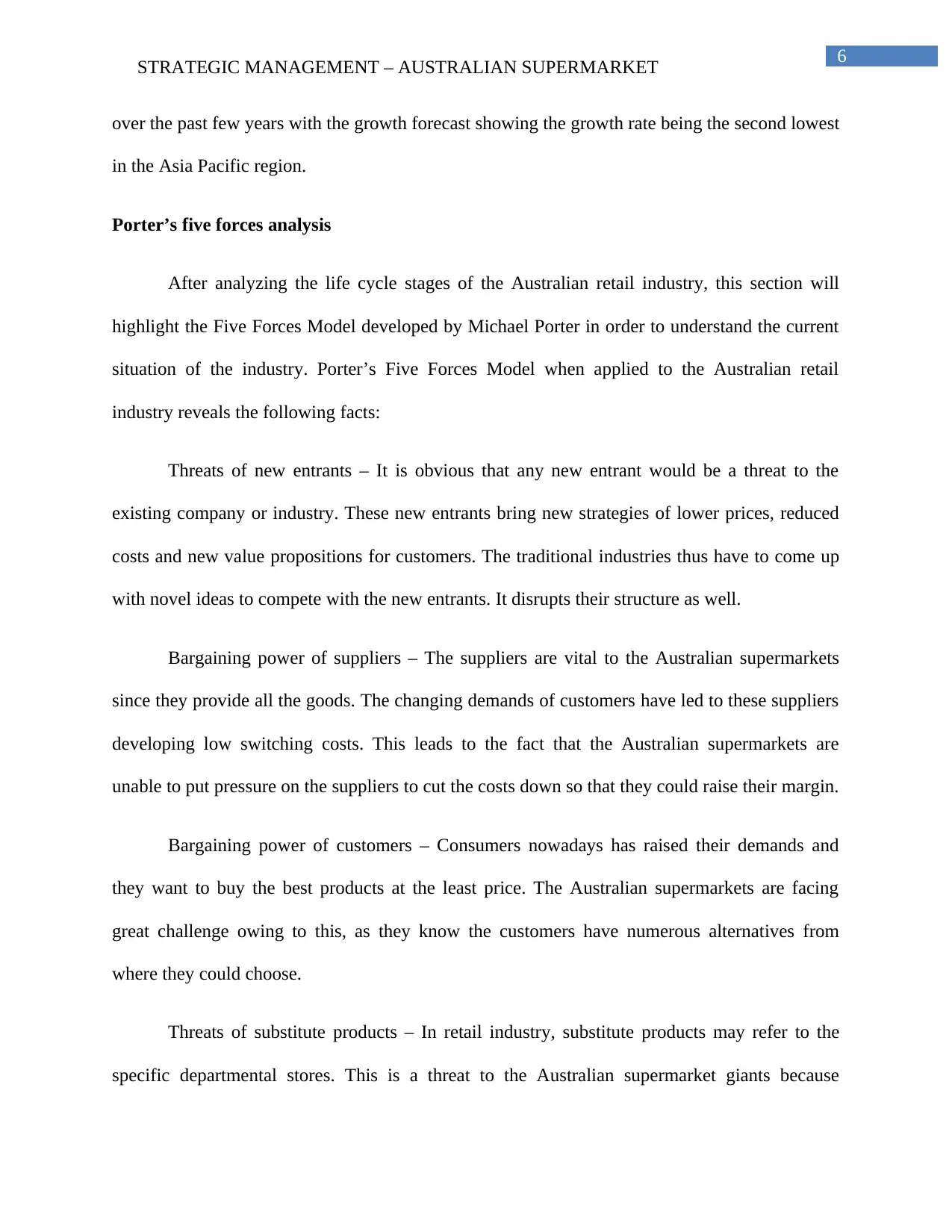
6
STRATEGIC MANAGEMENT – AUSTRALIAN SUPERMARKET
over the past few years with the growth forecast showing the growth rate being the second lowest
in the Asia Pacific region.
Porter’s five forces analysis
After analyzing the life cycle stages of the Australian retail industry, this section will
highlight the Five Forces Model developed by Michael Porter in order to understand the current
situation of the industry. Porter’s Five Forces Model when applied to the Australian retail
industry reveals the following facts:
Threats of new entrants – It is obvious that any new entrant would be a threat to the
existing company or industry. These new entrants bring new strategies of lower prices, reduced
costs and new value propositions for customers. The traditional industries thus have to come up
with novel ideas to compete with the new entrants. It disrupts their structure as well.
Bargaining power of suppliers – The suppliers are vital to the Australian supermarkets
since they provide all the goods. The changing demands of customers have led to these suppliers
developing low switching costs. This leads to the fact that the Australian supermarkets are
unable to put pressure on the suppliers to cut the costs down so that they could raise their margin.
Bargaining power of customers – Consumers nowadays has raised their demands and
they want to buy the best products at the least price. The Australian supermarkets are facing
great challenge owing to this, as they know the customers have numerous alternatives from
where they could choose.
Threats of substitute products – In retail industry, substitute products may refer to the
specific departmental stores. This is a threat to the Australian supermarket giants because
STRATEGIC MANAGEMENT – AUSTRALIAN SUPERMARKET
over the past few years with the growth forecast showing the growth rate being the second lowest
in the Asia Pacific region.
Porter’s five forces analysis
After analyzing the life cycle stages of the Australian retail industry, this section will
highlight the Five Forces Model developed by Michael Porter in order to understand the current
situation of the industry. Porter’s Five Forces Model when applied to the Australian retail
industry reveals the following facts:
Threats of new entrants – It is obvious that any new entrant would be a threat to the
existing company or industry. These new entrants bring new strategies of lower prices, reduced
costs and new value propositions for customers. The traditional industries thus have to come up
with novel ideas to compete with the new entrants. It disrupts their structure as well.
Bargaining power of suppliers – The suppliers are vital to the Australian supermarkets
since they provide all the goods. The changing demands of customers have led to these suppliers
developing low switching costs. This leads to the fact that the Australian supermarkets are
unable to put pressure on the suppliers to cut the costs down so that they could raise their margin.
Bargaining power of customers – Consumers nowadays has raised their demands and
they want to buy the best products at the least price. The Australian supermarkets are facing
great challenge owing to this, as they know the customers have numerous alternatives from
where they could choose.
Threats of substitute products – In retail industry, substitute products may refer to the
specific departmental stores. This is a threat to the Australian supermarket giants because
Paraphrase This Document
Need a fresh take? Get an instant paraphrase of this document with our AI Paraphraser

7
STRATEGIC MANAGEMENT – AUSTRALIAN SUPERMARKET
customers often prefer buying products from nearby departmental stores rather than traveling
farther distance to buy things from the bigger stores.
Rivalry amongst competitors – As evident from the case study, the rivalry between
Woolworths and Coles has been detrimental to the Australian supermarkets and retail industry
because it allowed foreign brands like Aldi to enter the business and dominate a major portion of
the market.
Company analysis
The macro environmental analysis provided an overview of the external factors that
influenced Woolworths and this section would analyze the company’s core competencies,
abilities and such other aspects. The VRIO (Value, Rareness, Imitability and Organization)
framework is ideal for analyzing these aspects, which would help identify the strategies that
could be most effective in achieving company objectives. The table provided below is explained
in order to analyze the company.
Is the
capability
valuable?
Is the
capability
rare?
Is the
capability
costly to
imitate?
Is the
capability
non-
substitutable?
Competitive
consequences
Performance
implications
No No No No Competitive
disadvantage
Below-average
returns
Yes No No Yes/No Competitive
rivalry
Average
returns
Yes Yes No Yes/No Temporary
competitive
Average
returns to
STRATEGIC MANAGEMENT – AUSTRALIAN SUPERMARKET
customers often prefer buying products from nearby departmental stores rather than traveling
farther distance to buy things from the bigger stores.
Rivalry amongst competitors – As evident from the case study, the rivalry between
Woolworths and Coles has been detrimental to the Australian supermarkets and retail industry
because it allowed foreign brands like Aldi to enter the business and dominate a major portion of
the market.
Company analysis
The macro environmental analysis provided an overview of the external factors that
influenced Woolworths and this section would analyze the company’s core competencies,
abilities and such other aspects. The VRIO (Value, Rareness, Imitability and Organization)
framework is ideal for analyzing these aspects, which would help identify the strategies that
could be most effective in achieving company objectives. The table provided below is explained
in order to analyze the company.
Is the
capability
valuable?
Is the
capability
rare?
Is the
capability
costly to
imitate?
Is the
capability
non-
substitutable?
Competitive
consequences
Performance
implications
No No No No Competitive
disadvantage
Below-average
returns
Yes No No Yes/No Competitive
rivalry
Average
returns
Yes Yes No Yes/No Temporary
competitive
Average
returns to
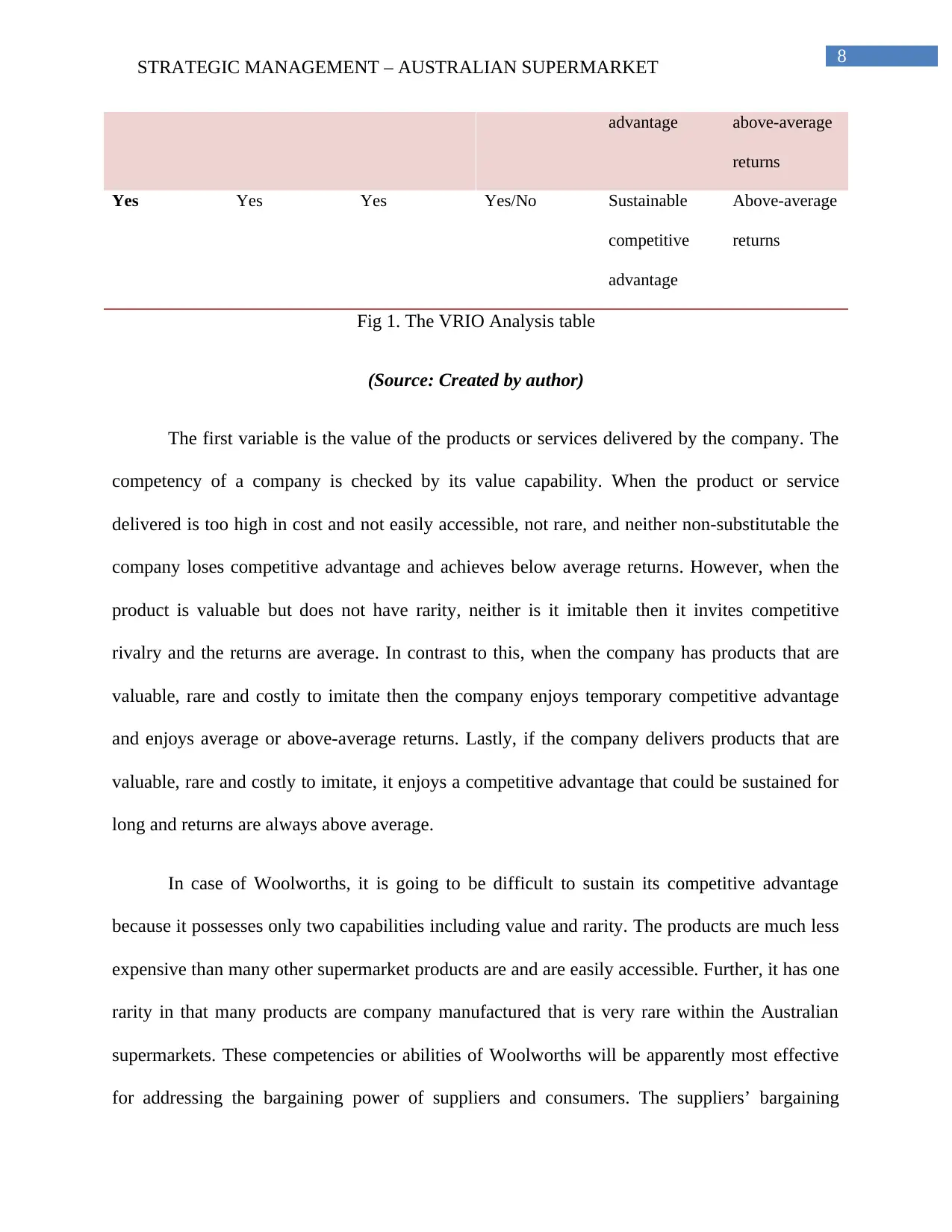
8
STRATEGIC MANAGEMENT – AUSTRALIAN SUPERMARKET
advantage above-average
returns
Yes Yes Yes Yes/No Sustainable
competitive
advantage
Above-average
returns
Fig 1. The VRIO Analysis table
(Source: Created by author)
The first variable is the value of the products or services delivered by the company. The
competency of a company is checked by its value capability. When the product or service
delivered is too high in cost and not easily accessible, not rare, and neither non-substitutable the
company loses competitive advantage and achieves below average returns. However, when the
product is valuable but does not have rarity, neither is it imitable then it invites competitive
rivalry and the returns are average. In contrast to this, when the company has products that are
valuable, rare and costly to imitate then the company enjoys temporary competitive advantage
and enjoys average or above-average returns. Lastly, if the company delivers products that are
valuable, rare and costly to imitate, it enjoys a competitive advantage that could be sustained for
long and returns are always above average.
In case of Woolworths, it is going to be difficult to sustain its competitive advantage
because it possesses only two capabilities including value and rarity. The products are much less
expensive than many other supermarket products are and are easily accessible. Further, it has one
rarity in that many products are company manufactured that is very rare within the Australian
supermarkets. These competencies or abilities of Woolworths will be apparently most effective
for addressing the bargaining power of suppliers and consumers. The suppliers’ bargaining
STRATEGIC MANAGEMENT – AUSTRALIAN SUPERMARKET
advantage above-average
returns
Yes Yes Yes Yes/No Sustainable
competitive
advantage
Above-average
returns
Fig 1. The VRIO Analysis table
(Source: Created by author)
The first variable is the value of the products or services delivered by the company. The
competency of a company is checked by its value capability. When the product or service
delivered is too high in cost and not easily accessible, not rare, and neither non-substitutable the
company loses competitive advantage and achieves below average returns. However, when the
product is valuable but does not have rarity, neither is it imitable then it invites competitive
rivalry and the returns are average. In contrast to this, when the company has products that are
valuable, rare and costly to imitate then the company enjoys temporary competitive advantage
and enjoys average or above-average returns. Lastly, if the company delivers products that are
valuable, rare and costly to imitate, it enjoys a competitive advantage that could be sustained for
long and returns are always above average.
In case of Woolworths, it is going to be difficult to sustain its competitive advantage
because it possesses only two capabilities including value and rarity. The products are much less
expensive than many other supermarket products are and are easily accessible. Further, it has one
rarity in that many products are company manufactured that is very rare within the Australian
supermarkets. These competencies or abilities of Woolworths will be apparently most effective
for addressing the bargaining power of suppliers and consumers. The suppliers’ bargaining
⊘ This is a preview!⊘
Do you want full access?
Subscribe today to unlock all pages.

Trusted by 1+ million students worldwide
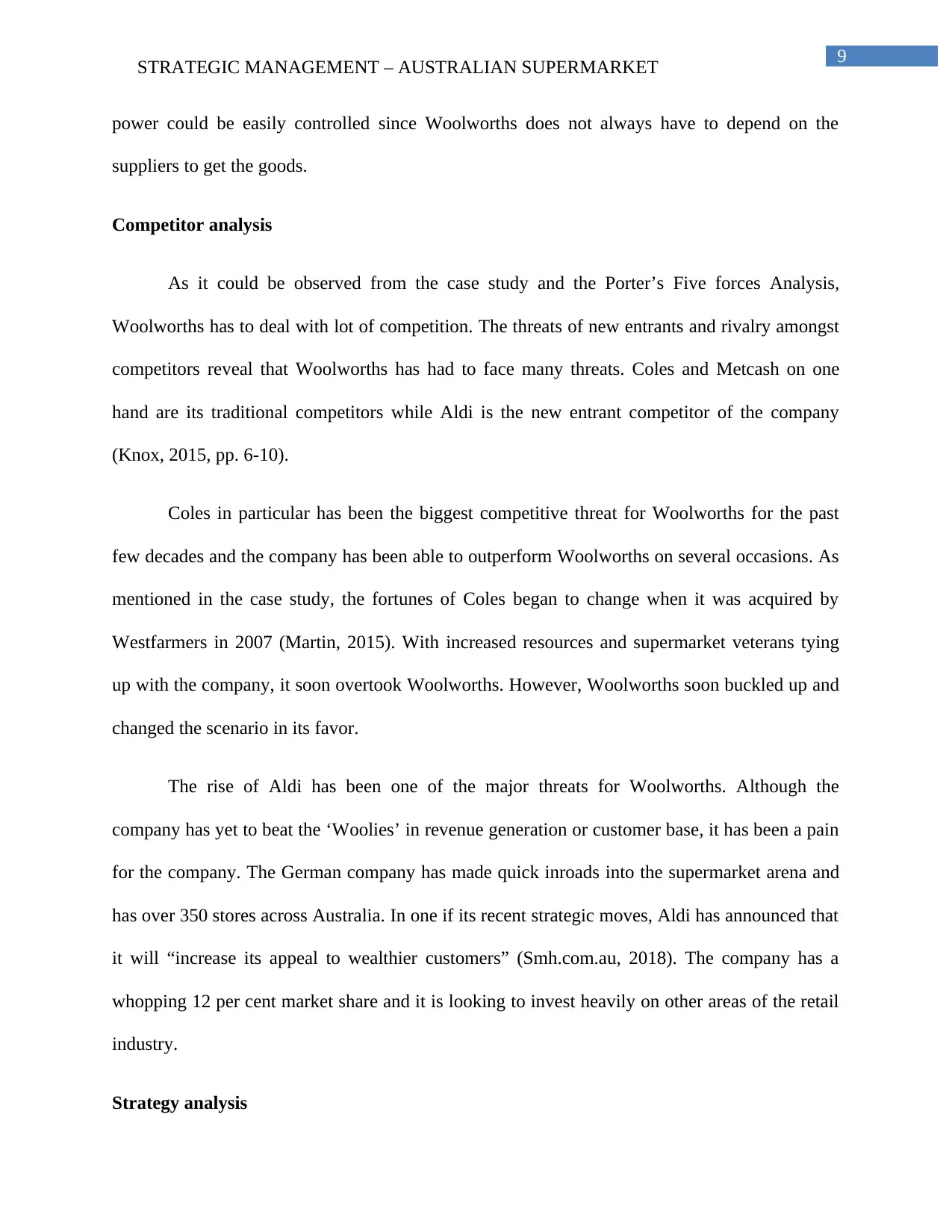
9
STRATEGIC MANAGEMENT – AUSTRALIAN SUPERMARKET
power could be easily controlled since Woolworths does not always have to depend on the
suppliers to get the goods.
Competitor analysis
As it could be observed from the case study and the Porter’s Five forces Analysis,
Woolworths has to deal with lot of competition. The threats of new entrants and rivalry amongst
competitors reveal that Woolworths has had to face many threats. Coles and Metcash on one
hand are its traditional competitors while Aldi is the new entrant competitor of the company
(Knox, 2015, pp. 6-10).
Coles in particular has been the biggest competitive threat for Woolworths for the past
few decades and the company has been able to outperform Woolworths on several occasions. As
mentioned in the case study, the fortunes of Coles began to change when it was acquired by
Westfarmers in 2007 (Martin, 2015). With increased resources and supermarket veterans tying
up with the company, it soon overtook Woolworths. However, Woolworths soon buckled up and
changed the scenario in its favor.
The rise of Aldi has been one of the major threats for Woolworths. Although the
company has yet to beat the ‘Woolies’ in revenue generation or customer base, it has been a pain
for the company. The German company has made quick inroads into the supermarket arena and
has over 350 stores across Australia. In one if its recent strategic moves, Aldi has announced that
it will “increase its appeal to wealthier customers” (Smh.com.au, 2018). The company has a
whopping 12 per cent market share and it is looking to invest heavily on other areas of the retail
industry.
Strategy analysis
STRATEGIC MANAGEMENT – AUSTRALIAN SUPERMARKET
power could be easily controlled since Woolworths does not always have to depend on the
suppliers to get the goods.
Competitor analysis
As it could be observed from the case study and the Porter’s Five forces Analysis,
Woolworths has to deal with lot of competition. The threats of new entrants and rivalry amongst
competitors reveal that Woolworths has had to face many threats. Coles and Metcash on one
hand are its traditional competitors while Aldi is the new entrant competitor of the company
(Knox, 2015, pp. 6-10).
Coles in particular has been the biggest competitive threat for Woolworths for the past
few decades and the company has been able to outperform Woolworths on several occasions. As
mentioned in the case study, the fortunes of Coles began to change when it was acquired by
Westfarmers in 2007 (Martin, 2015). With increased resources and supermarket veterans tying
up with the company, it soon overtook Woolworths. However, Woolworths soon buckled up and
changed the scenario in its favor.
The rise of Aldi has been one of the major threats for Woolworths. Although the
company has yet to beat the ‘Woolies’ in revenue generation or customer base, it has been a pain
for the company. The German company has made quick inroads into the supermarket arena and
has over 350 stores across Australia. In one if its recent strategic moves, Aldi has announced that
it will “increase its appeal to wealthier customers” (Smh.com.au, 2018). The company has a
whopping 12 per cent market share and it is looking to invest heavily on other areas of the retail
industry.
Strategy analysis
Paraphrase This Document
Need a fresh take? Get an instant paraphrase of this document with our AI Paraphraser
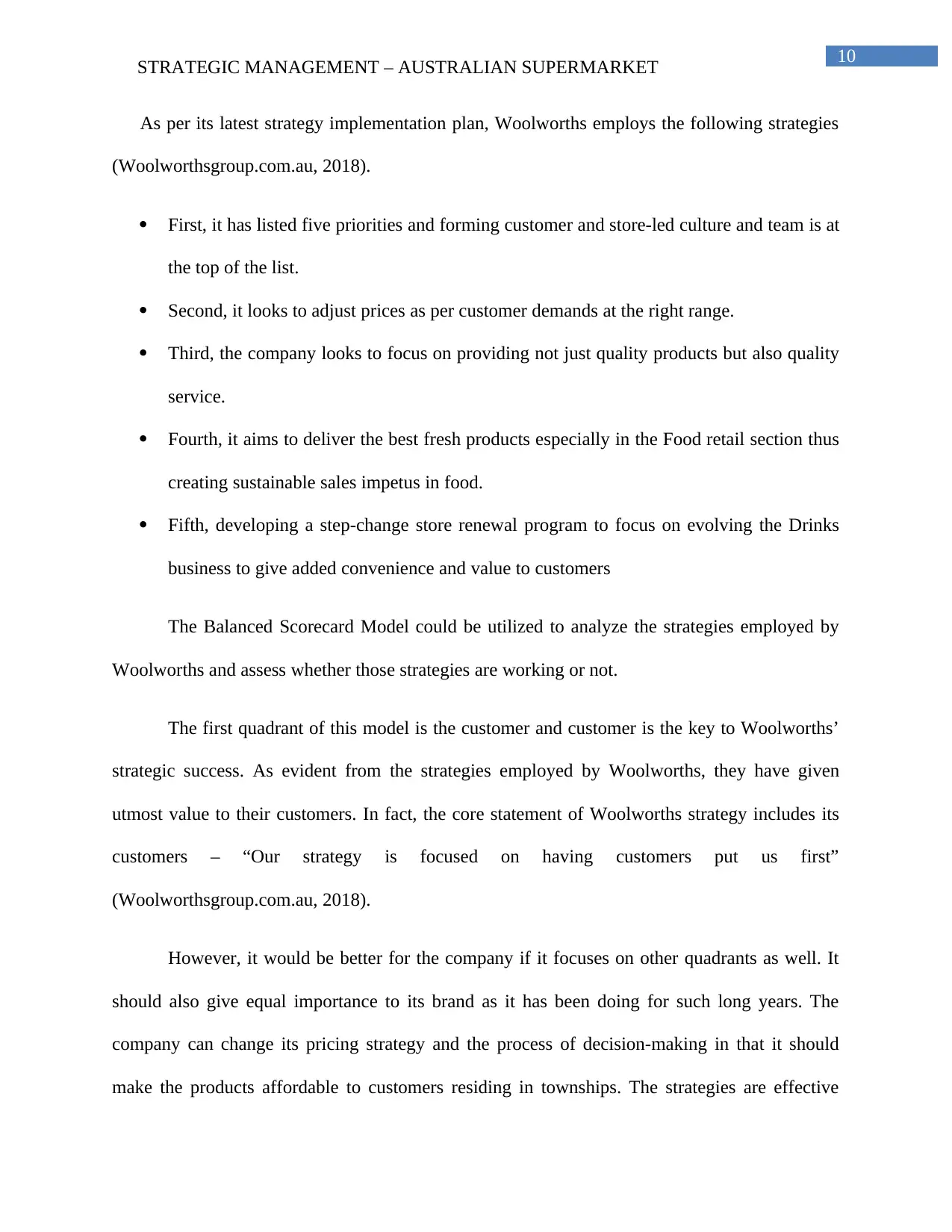
10
STRATEGIC MANAGEMENT – AUSTRALIAN SUPERMARKET
As per its latest strategy implementation plan, Woolworths employs the following strategies
(Woolworthsgroup.com.au, 2018).
First, it has listed five priorities and forming customer and store-led culture and team is at
the top of the list.
Second, it looks to adjust prices as per customer demands at the right range.
Third, the company looks to focus on providing not just quality products but also quality
service.
Fourth, it aims to deliver the best fresh products especially in the Food retail section thus
creating sustainable sales impetus in food.
Fifth, developing a step-change store renewal program to focus on evolving the Drinks
business to give added convenience and value to customers
The Balanced Scorecard Model could be utilized to analyze the strategies employed by
Woolworths and assess whether those strategies are working or not.
The first quadrant of this model is the customer and customer is the key to Woolworths’
strategic success. As evident from the strategies employed by Woolworths, they have given
utmost value to their customers. In fact, the core statement of Woolworths strategy includes its
customers – “Our strategy is focused on having customers put us first”
(Woolworthsgroup.com.au, 2018).
However, it would be better for the company if it focuses on other quadrants as well. It
should also give equal importance to its brand as it has been doing for such long years. The
company can change its pricing strategy and the process of decision-making in that it should
make the products affordable to customers residing in townships. The strategies are effective
STRATEGIC MANAGEMENT – AUSTRALIAN SUPERMARKET
As per its latest strategy implementation plan, Woolworths employs the following strategies
(Woolworthsgroup.com.au, 2018).
First, it has listed five priorities and forming customer and store-led culture and team is at
the top of the list.
Second, it looks to adjust prices as per customer demands at the right range.
Third, the company looks to focus on providing not just quality products but also quality
service.
Fourth, it aims to deliver the best fresh products especially in the Food retail section thus
creating sustainable sales impetus in food.
Fifth, developing a step-change store renewal program to focus on evolving the Drinks
business to give added convenience and value to customers
The Balanced Scorecard Model could be utilized to analyze the strategies employed by
Woolworths and assess whether those strategies are working or not.
The first quadrant of this model is the customer and customer is the key to Woolworths’
strategic success. As evident from the strategies employed by Woolworths, they have given
utmost value to their customers. In fact, the core statement of Woolworths strategy includes its
customers – “Our strategy is focused on having customers put us first”
(Woolworthsgroup.com.au, 2018).
However, it would be better for the company if it focuses on other quadrants as well. It
should also give equal importance to its brand as it has been doing for such long years. The
company can change its pricing strategy and the process of decision-making in that it should
make the products affordable to customers residing in townships. The strategies are effective
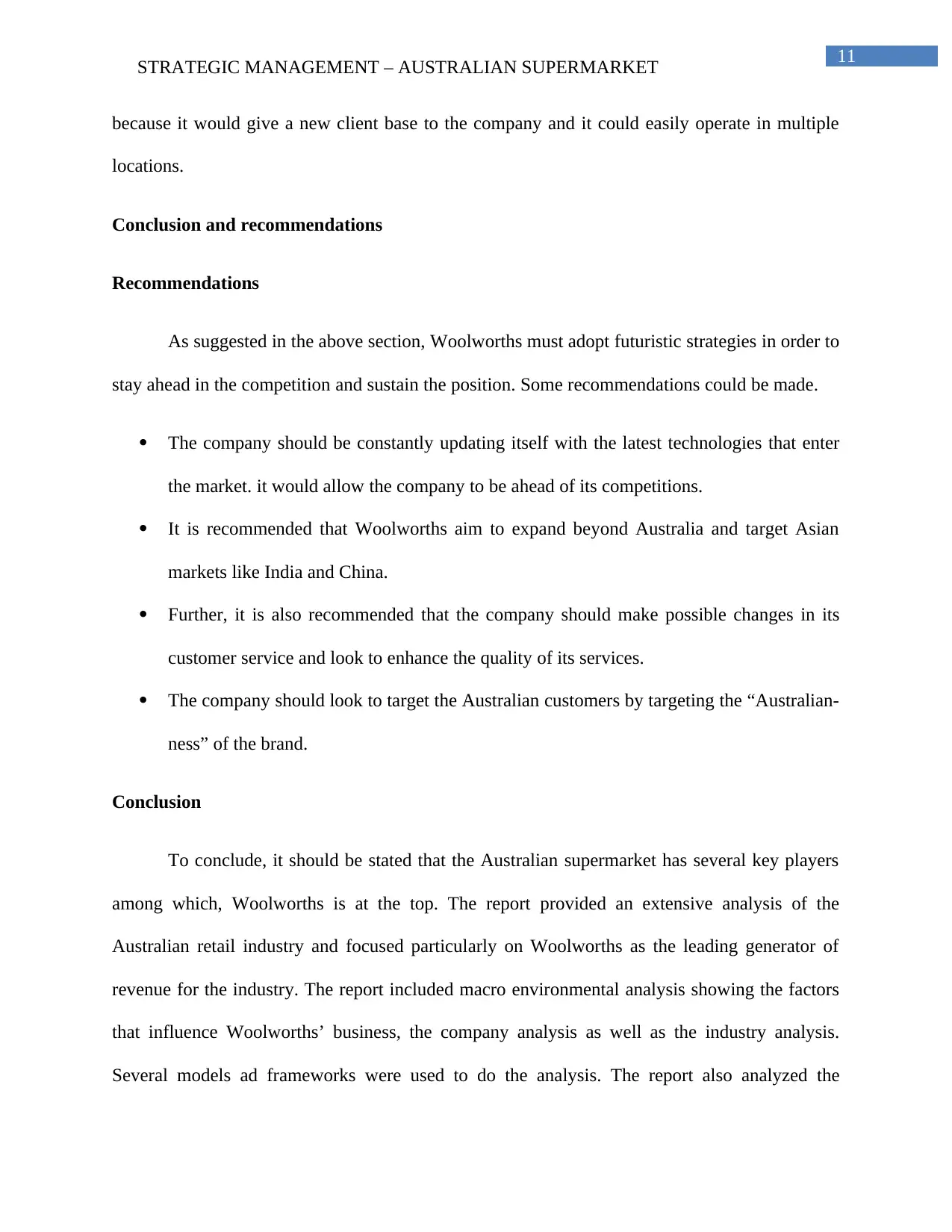
11
STRATEGIC MANAGEMENT – AUSTRALIAN SUPERMARKET
because it would give a new client base to the company and it could easily operate in multiple
locations.
Conclusion and recommendations
Recommendations
As suggested in the above section, Woolworths must adopt futuristic strategies in order to
stay ahead in the competition and sustain the position. Some recommendations could be made.
The company should be constantly updating itself with the latest technologies that enter
the market. it would allow the company to be ahead of its competitions.
It is recommended that Woolworths aim to expand beyond Australia and target Asian
markets like India and China.
Further, it is also recommended that the company should make possible changes in its
customer service and look to enhance the quality of its services.
The company should look to target the Australian customers by targeting the “Australian-
ness” of the brand.
Conclusion
To conclude, it should be stated that the Australian supermarket has several key players
among which, Woolworths is at the top. The report provided an extensive analysis of the
Australian retail industry and focused particularly on Woolworths as the leading generator of
revenue for the industry. The report included macro environmental analysis showing the factors
that influence Woolworths’ business, the company analysis as well as the industry analysis.
Several models ad frameworks were used to do the analysis. The report also analyzed the
STRATEGIC MANAGEMENT – AUSTRALIAN SUPERMARKET
because it would give a new client base to the company and it could easily operate in multiple
locations.
Conclusion and recommendations
Recommendations
As suggested in the above section, Woolworths must adopt futuristic strategies in order to
stay ahead in the competition and sustain the position. Some recommendations could be made.
The company should be constantly updating itself with the latest technologies that enter
the market. it would allow the company to be ahead of its competitions.
It is recommended that Woolworths aim to expand beyond Australia and target Asian
markets like India and China.
Further, it is also recommended that the company should make possible changes in its
customer service and look to enhance the quality of its services.
The company should look to target the Australian customers by targeting the “Australian-
ness” of the brand.
Conclusion
To conclude, it should be stated that the Australian supermarket has several key players
among which, Woolworths is at the top. The report provided an extensive analysis of the
Australian retail industry and focused particularly on Woolworths as the leading generator of
revenue for the industry. The report included macro environmental analysis showing the factors
that influence Woolworths’ business, the company analysis as well as the industry analysis.
Several models ad frameworks were used to do the analysis. The report also analyzed the
⊘ This is a preview!⊘
Do you want full access?
Subscribe today to unlock all pages.

Trusted by 1+ million students worldwide
1 out of 15
Related Documents
Your All-in-One AI-Powered Toolkit for Academic Success.
+13062052269
info@desklib.com
Available 24*7 on WhatsApp / Email
![[object Object]](/_next/static/media/star-bottom.7253800d.svg)
Unlock your academic potential
Copyright © 2020–2025 A2Z Services. All Rights Reserved. Developed and managed by ZUCOL.


